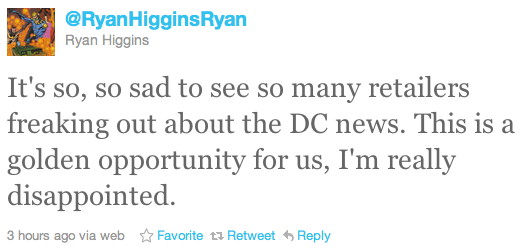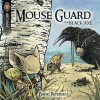The big news in the comic book industry this week was DC Comics’ announcement that it will be rebooting its universe and relaunching most of its titles with new #1 issues (52 new first issues, making me wonder – snarkily – if there will be one for each universe in its current multiverse). Presumably this relaunch is being explained in story terms due to the current event series Flashpoint, in which the DC Universe as we know it has been altered into a twisted version of itself, and that the untwisting will cause everything to be different.
As a longtime reader of DC Comics, I don’t have a strong reaction to this. My first thought is, “This is what they should have done in 1986 after Crisis on Infinite Earths!” In 1986 I was reading almost every title that DC printed (I was also 17 years old), and would have been very excited if they’d done something like this. (I’ve heard that they considered it but that editorial got cold feet and couldn’t pull the trigger.) 25 years later, this feels like little more than a gimmick, one tacked on to what was originally pushed as a Flash-centric event series. Now it feels like Flashpoint was just a means to reboot the continuity, which feels like it cheapens the story.
(I wonder if DC was emboldened to make this move by the success of 2009’s Star Trek film, which did the same thing for that franchise.)
It also makes the next few months worth of DC Universe titles feel irrelevant, too. J. Michael Straczynski – who has recently been pilloried for leaving the Superman and Wonder Woman titles in mid-story – had words in a similar vein on his Facebook fan page:
So I felt confident that it was coming soon (which is one reason why I felt there wouldn’t be a problem in the long run leaving the monthly books, since most of the things done in Superman and Wonder Woman would be erased by the reboot anyway, so ultimately it didn’t matter whether I stayed or left). I just couldn’t say anything at the time because I wanted to respect Dan’s privacy and his desire to do what he thought was right when he thought it was right to do it.
Superman and Wonder Woman are wrapping up major story arcs, the three Green Lantern titles are in the middle of a major crossover story, “War of the Green Lanterns”, the Batman status quo has been upset by Grant Morrison’s Batman Inc. set-up, and various developments have occurred due to Brightest Day. Now, all of these stories may have been good reads in their own right, but for people who care about the ongoing story developments, that means that everything that happened in them will now be swept away?
That’s another way in which events like this support my maxim that “a good jumping-on point for new readers is a good jumping-off point for old readers.” I’ve been losing interest in the Green Lantern titles since the plot has been getting ever-more grandiose and the character elements are vanishing, so this makes the reboot an excellent time for me to drop those books.
As far as whether I’ll buy any of the new first issues, what I usually do is follow the creators: I’ll buy the books by writers I like (and artists I really like, although even the presence of George Pérez wasn’t enough to persuade me to buy the Flashpoint tie-in mini-series Secret Seven this week), and probably pass on the rest unless the premise of one sounds unusually interesting. But I’m not going to pick up, say, a new Hawkman or Aquaman series just because. Of the first ten series announced, I might pick up Firestorm (Gail Simone, Yildiray Cinar), but that’s about it (I’ll stay far away from Flash, as I cannot stand Francis Manapul’s art these days).
I’ll also likely pass on the previously-announced Justice League title by Geoff Johns and Jim Lee, as I’m not really a fan of Lee’s art, and I find Johns’ writing to be increasingly pedestrian these days. (Johns and Lee on Justice League is about twenty steps down from Kurt Busiek and George Pérez on Avengers a decade ago.) Honestly the only books Johns has written that really stand out in my mind are his first Flash run (with Scott Kolins and Howard Porter), and his Booster Gold run.
So my reaction to all of this on the creative side is basically one of “whatever”. When they announce that Ed Brubaker or Kurt Busiek or Mark Waid or a writer I similarly admire is writing one of the new titles, then I’ll be excited. Otherwise it’s just more superhero comics, reboot or no reboot.
If they’re really going to relaunch the industry’s long-standing titles – Action Comics and Detective Comics – with new first issues, that’s a little sad (Action just hit #900, and it’d be neat to see it hit #1000 in about 8 years without ever going through a numbering change), but I have no doubt that many books will revert to their historical numbering for their next major milestone issues (et tu FF, née Fantastic Four?).
Buried in the announcements – but called out by a few bloggers – was the parallel announcement that DC would be releasing new comics digitally on the same day of the print release. (For some reason they’re calling this “digital day-and-date”, which must be some term I’ve just not heard before, but it sure sounds stupid. “Day and date”? What would “day or date” be? What about just “day”? They couldn’t call it “same day” or “simultaneous digital release” or something clearer?) This makes various people happy or mad depending (as far as I can tell) on their take on whether digital comics indicate the impending doom of print comics or not, and whether they think that’s a good thing.
I have little interest in digital comics myself, though I expect that over the next 20 years or so we’ll see the monthly comic industry (mostly) die in favor of digital comics. Whether I’ll go along to the new medium I don’t know – I probably will, although I’ll likely still prefer print comics (after all, I know I’ll be able to read print comics in 40 years; whether any particular digital format will still be supported then, who can say?). It is interesting to see DC so fully embracing digital comics; whether their major competitors other than Marvel can keep up will be a good question, since if this move spells death for any of Dark Horse, Image, IDW, and the like, that’s a good thing for DC. It’s a bad thing for readers, of course. Though there’s plenty of innovation going on in the really small presses, not to mention in the webcomics community, arguably more than we see from any of the major comics companies, so for people like me motivated to seek out good reading material, I’m sure it will always be out there. Just in a different form – and maybe not from your local comics shop.
Ultimately, I think that where printed reading material is concerned, we really are entering a singularity: I don’t think anyone can truly say what the book and comic industries will look like in 20 years. Maybe it’ll be all digital, maybe it’ll be mostly digital with a smattering of print companies and stores mostly for collectors (this is my guess), maybe the digital and print industries will coexist in similar sizes and compete with each other. 20 years is a long way out, and we’re at the very beginning of the transition. But I would not be at all surprised to see 50% or more comic book stores go out of business within 10 years. (Sad, but not surprised.)
Lots of people are predictably cynical about this. I’m trying to be realistic rather than cynical (although I am cynical where DC’s editorial direction is concerned; annual crossover events tend to do that to me). Ryan, the owner of the comic shop I go to, Comics Conspiracy, is pretty excited, though, and is a bit disappointed in some of his fellow retailers:

People fear change. People especially fear change that threatens to disrupt their livelihood. I bet a few retailers would say that Ryan is a brave man to embrace it.
I agree with Ryan that the reboot is a big opportunity for retailers – but in the short term. I can also understand Brian Hibbs’ reaction, which seems centered around “Holy crap! 52 first issues in one month?” But this is an opportunity to try to bring in some new readers in the back third of 2011. After that, though, I don’t have a lot of confidence in DC to be able to actually take their line anywhere, or let their better creators follow through on their own visions. DC’s been flitting from crossover event to crossover event for a decade now, and the company has seemed to just be meandering around like some kid with ADD in a store full of shiny objects. Will anyone care about the reboot a year from now? Will it have made any difference? How about 2 years from now?
The long-term aspect of this announcement is how digital downloads will change the industry – and the publishers’ dispositions to the direct market – over the next decade. That’s where the big changes are going to come. And whether that will be a golden opportunity for retailers remains to be seen.




























